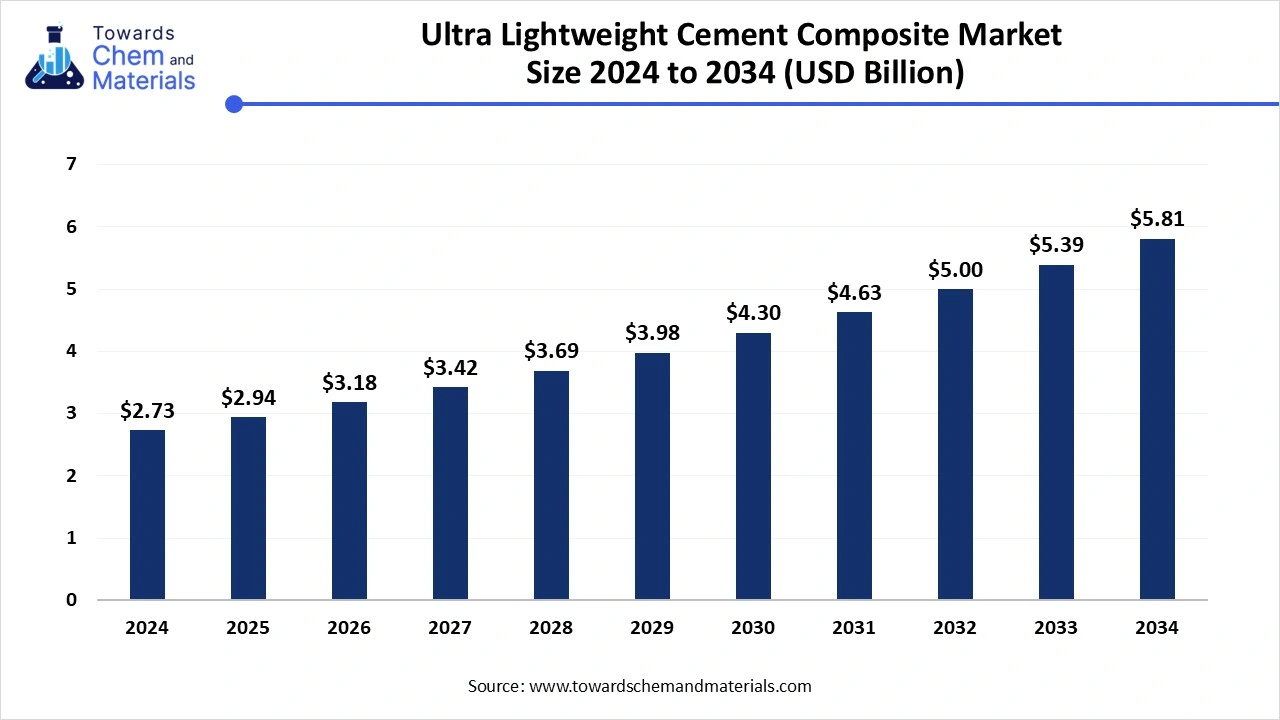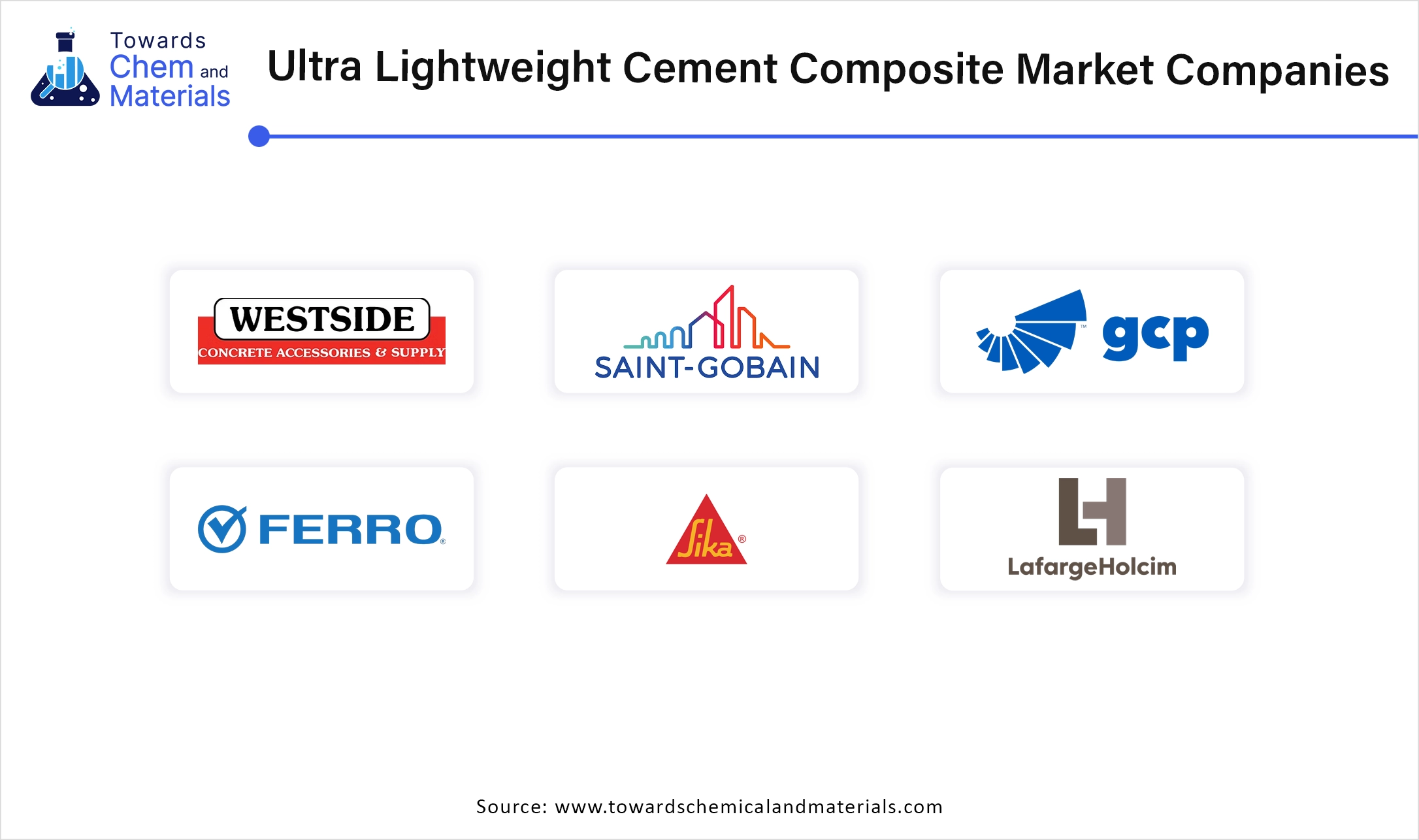March 2025
The global ultra lightweight cement composite market size accounted for USD 2.73 billion in 2024 and is predicted to increase from USD 2.94 billion in 2025 to approximately USD 5.81 billion by 2034, expanding at a CAGR of 7.85% from 2025 to 2034. The growing demand for sustainable product use and increasing demand for green buildings by consumers help in the growth of the market.

Ultra-lightweight cement composites are a construction material that integrates cement with innovative additives, yielding a remarkably light yet robust product. Its unique properties enhance energy efficiency, reduce weight, and increase durability. The demand for low-carbon, energy-efficient materials is increasing the demand for ultra-lightweight cement composite, leading towards sustainability and the green construction goal.
The ultra-lightweight cement composites market is increasing due to sustainability goals, urbanization, and technology advancements. The use of recycled materials, advanced fibres, 3D printing, and multi-functional composites drives the market ultra-lightweight cement composite market.
The focus on R&D and partnerships to develop next-generation materials increases the demand for the market. The market is growing significantly, driven by increasing demand for energy-efficient and sustainable building solutions. As the industry is evolving, ultra-lightweight cement composites are playing a crucial role in shaping the future of construction with their innovation and advancement. Innovation and adoption will drive the growth of the ultra-lightweight cement composites market.
| Report Attributes | Details |
| Market Size in 2025 | USD 2.73 Billion |
| Expected Size in 2034 | USD 2.94 Billion |
| Growth Rate | CAGR of 7.85% from 2025 to 2034 |
| Base Year of Estimation | 2024 |
| Forecast Period | 2025-2034 |
| Dominant Region | North America |
| Segment Covered | By Application, By End Use, By Formulation Type, By Cement Type, By Region |
| Key Companies Profile | Westside Concrete Accessories,Saint-Gobain,GCP Applied Technologies,Ferro Corporation,Sika,LafargeHolcim,Boral Limited,Neumann Cement,BASF, Kryton International,Synaxis,UltraTech Cement,CRH,HeidelbergCement |
Carbon-neutral construction materials are essential for reducing the environmental impact of the construction industry, which is a major source of global carbon emissions. These materials produce minimal CO₂, which increases the demand for the material by consumers. The use of advances in manufacturing materials, such as using industrial by-products, renewable resources, and carbon capture technologies, makes them ideal for sustainable solutions.
These materials support sustainable construction practices and help meet green building initiatives standards like LEED and BREEAM. As climate goals become more urgent, carbon-neutral construction materials are playing a key role in the transition to greener infrastructure. These factors create a great opportunity for the growth and help achieve sustainable goals without hampering the quality and performance of the product, which expands the ultra-lightweight cement composite market rapidly.
One of the primary challenges in the adoption of ultra-lightweight cement composites (ULCCs) is their high initial cost. The materials are incorporated with specialized components such as lightweight aggregates, high-performance fibers, foaming agents, and nanomaterials, which contribute to increased production costs compared to traditional concrete.
The manufacturing process also requires precise control and advanced equipment, which results in a rise in overall cost. Limited availability of raw materials and lack of widespread expertise in mix design and application further inflate costs.
While life-cycle savings and environmental benefits make ultra-lightweight cement composites a smart investment in the long run, the high initial investment remains a significant barrier to their widespread adoption in mainstream construction projects.
The North American region has a mature market for the ultra-lightweight cement composites due to their properties.
The North American region dominated the ultra-lightweight cement composite market in 2024. The ultra-lightweight cement composite is a mature market that is driven by green building regulations, advanced construction technologies, and demand for energy-efficient materials. Strong focus on sustainable construction, energy efficiency, and structural innovation drives the market in the region.
The initiative supporting sustainable development, like net-zero carbon emission and integration of smart construction technology, such as 3D printing, opens new opportunities for ultra-lightweight cement composites applications in the region. Overall, the North America region maintains steady growth in the ultra-lightweight cement composites market, fuelled by innovative and sustainability-driven initiatives and policies.
The countries like Canada and the USA lead in the market due to dynamic technology.
The USA and Canada lead in the adoption of ultra-lightweight cement composites market, particularly in sectors like commercial buildings, infrastructure retrofitting, and modular construction. Stringent building codes and green building certifications such as LEED have accelerated demand for eco-friendly materials with low carbon emission and high thermal performance as the product attracts the consumer and helps in the growth.
The Asia Pacific region witnesses growth due to the increasing and growing construction industry in the region.
The Asia Pacific region is anticipated to grow significantly in the ultra-lightweight cement composite market in the forecasted period. The growing urbanisation, infrastructural expansion, and government-supported initiatives fuel the demand for lightweight and durable building materials.
The region is also witnessing rapid growth in the Ultra-Lightweight Cement demand due to population growth and large-scale infrastructure projects. The region's expanding prefabricated construction sector also favors ultra-lightweight cement composite for its reduced weight, improved handling, and thermal insulation properties. These factors drive the growth of the market.
Countries like China and India are experiencing growth due to rising demand for sustainable products.
Countries like China, India, and Japan are at the forefront, with rising demand for sustainable, cost-effective, and high-performance construction materials. Government initiatives promoting green buildings, affordable housing, and smart cities are accelerating the adoption of ultra-lightweight cement composite. Increasing investment in R&D and favorable regulatory support by the government led the market in the region.
The construction segment dominated the market in 2024. In the construction sector, the ultra-lightweight cement composite is gaining the attention of consumers due to its low density, high strength, and superior thermal and acoustic insulation. They also offer consumers reduced structural load, enhanced energy efficiency, and easier handling during construction.
The ultra-lightweight cement composite is also ideal for the construction of green buildings, supporting the initiatives that align with sustainable goals. They offer the consumers long-term advantages in terms of maintenance, durability, and operational efficiency, which makes them ideal and a preferred choice in both residential and commercial construction. This results in the expansion and growth of the ultra-lightweight cement composite market.
The prefabricated segment expects significant growth in the ultra-lightweight cement composite market during the forecast period. The ultra-lightweight cement composite is a key component in the prefabricated construction sector, where speed, efficiency, and material performance a crucial and critical.
The low weight and high strength-to-weight ratio of the product, the ultra-lightweight cement composite, are ideal for manufacturing modular panels, wall systems, floor slabs, and insulated blocks off-site. This also helps reduce the transportation cost, simplifies installations, and minimizes the on-site labor. The ultra-lightweight cement composite also helps in sustainable and eco-friendly usage of the products and helps achieve goals as they use recycled content and reduce material waste during production.
The growing demand for affordable, fast building, and eco-friendly structures increases the demand for the market and helps in the expansion of the ultra-lightweight cement composite market.
The industrial segment dominated the market in 2024. In industrial construction, the ultra-lightweight cement composite is emerging as a valuable material as it offers consumers properties such as durability, reduced dead load, and resistance to environmental stressors.
They also offer high chemical resistance, which makes them suitable for the industrial sector that deals with corrosive substances or in harsh operational conditions. The materials' adaptability for precast and modular systems supports faster construction timelines and reduces downtime, which is important in an industrial setting.
The soundproofing, fire resistance, and thermal insulation qualities also enhance the safety and comfort in the industrial environment. Increasing trend towards green industry development attracts many consumers, which helps the ultra-lightweight cement composite market to grow significantly.
The residential segment expects significant growth in the ultra-lightweight cement composite market during the forecast period. The ultra-lightweight cement composite is gaining attention in residential construction because of its structural strength, thermal efficiency, and because it helps in reducing building weight. The ultra-lightweight cement composite helps lower the structural load, which makes it ideal for multi-story housing and retrofitting older buildings.
The thermal and acoustic insulations help improve the indoor comfort and reduce energy cost, aligning with the rising demand for energy-efficient and sustainable homes. The use of recycled material in the ultra-lightweight cement composite supports green building initiatives and attracts the environmentally conscious consumers, which helps the market to grow.
Long-term savings on energy, maintenance, and durability make the ultra-lightweight cement composite a smart investment for residential consumers these factors the ultra-lightweight cement composite market growth steadily.
The ready-mix segment dominated the market in 2024. The ultra-lightweight cement composite is increasingly used in ready mix concrete applications, which offers a convenient and efficient solution for projects that demand high performance with reduced weight. The ready mix is produced in controlled batches, ensuring consistency in quality and time-saving benefits. The ready mix is used mostly for residential, commercial, and infrastructural projects, where real-time mixing is not possible and is time sensitive.
The integration of the ultra-lightweight cement composite into the ready-mix enhances the thermal insulation, low density, and improves flowability, which makes them ideal for lightweight floor screeds, roof decks, non-loading, and void fills. The use of ready mix helps and supports sustainable construction as the ultra-lightweight cement composite mix contains industrial by-products and recycled aggregates, which are steps in the sustainable development. These factors influence the market expansion and help in the ultra-lightweight cement composite market growth.
The precast segment expects significant growth in the ultra-lightweight cement composite market during the forecast period. The precast offers significant benefits in terms of ease of handling, reduced transportation cost, and faster installation. In precast installation, the ultra-lightweight cement composite is used to manufacture wall panels, cladding elements, floor slabs, partition systems, and modular components.
The properties, such as low density, help reduce the structural load, making them ideal for high-rise and modular construction. The ultra-lightweight cement composite also provides thermal and acoustic insulation, increasing the demand for energy-efficient buildings.
The ultra-lightweight cement composite-based precast components are particularly beneficial in urban construction, where site space and logistics are limited. The steady increase in both residential and commercial sector demands for the segment helps the ultra-lightweight cement composite market to grow.
The portland cement segment dominated the market in 2024. The Portland cement is a primary binder in the ultra-lightweight cement composites. Which provides strength, durability, and setting characteristics. In the formulation of the cement, Portland cement is combined with lightweight aggregate and fibers to reduce density while maintaining the structural integrity of the product.
The advancement in nano-engineering and carbon-cured concrete aims to enhance the efficiency and sustainability of the Portland cement in the ultra-lightweight cement composite applications, Portland cement remains the foundational material due to its reliability; these factors help the market growth and expansion of the ultra-lightweight cement composite market rapidly.
The blended cement segment expects significant growth in the ultra-lightweight cement composite market during the forecast period. The blended cement plays a key role in the formulation of the ultra-lightweight cement, as it offers consumers a more sustainable and performance-enhancing alternative to the traditional cement.
The blended cement uses supplementary cementitious materials, which help to reduce the carbon footprint and improve durability, workability, and thermal resistance. The blended cement has low density, which helps in maintaining the structural strength and enhances the long-term performance.
They are mostly used in the application of precast panels, insulating blocks, and lightweight flooring systems, as they also support lower heat of hydration, which makes them ideal for large ultra-lightweight cement composite elements where cracking due to temperature rise is a problem and a matter of concern. As the demand for eco-friendly and sustainable products grows, the demand for the ultra-lightweight cement composite market also increases, which drives the market.

By Application
By End Use
By Formulation Type
By Cement Type
By Regional
March 2025
March 2025